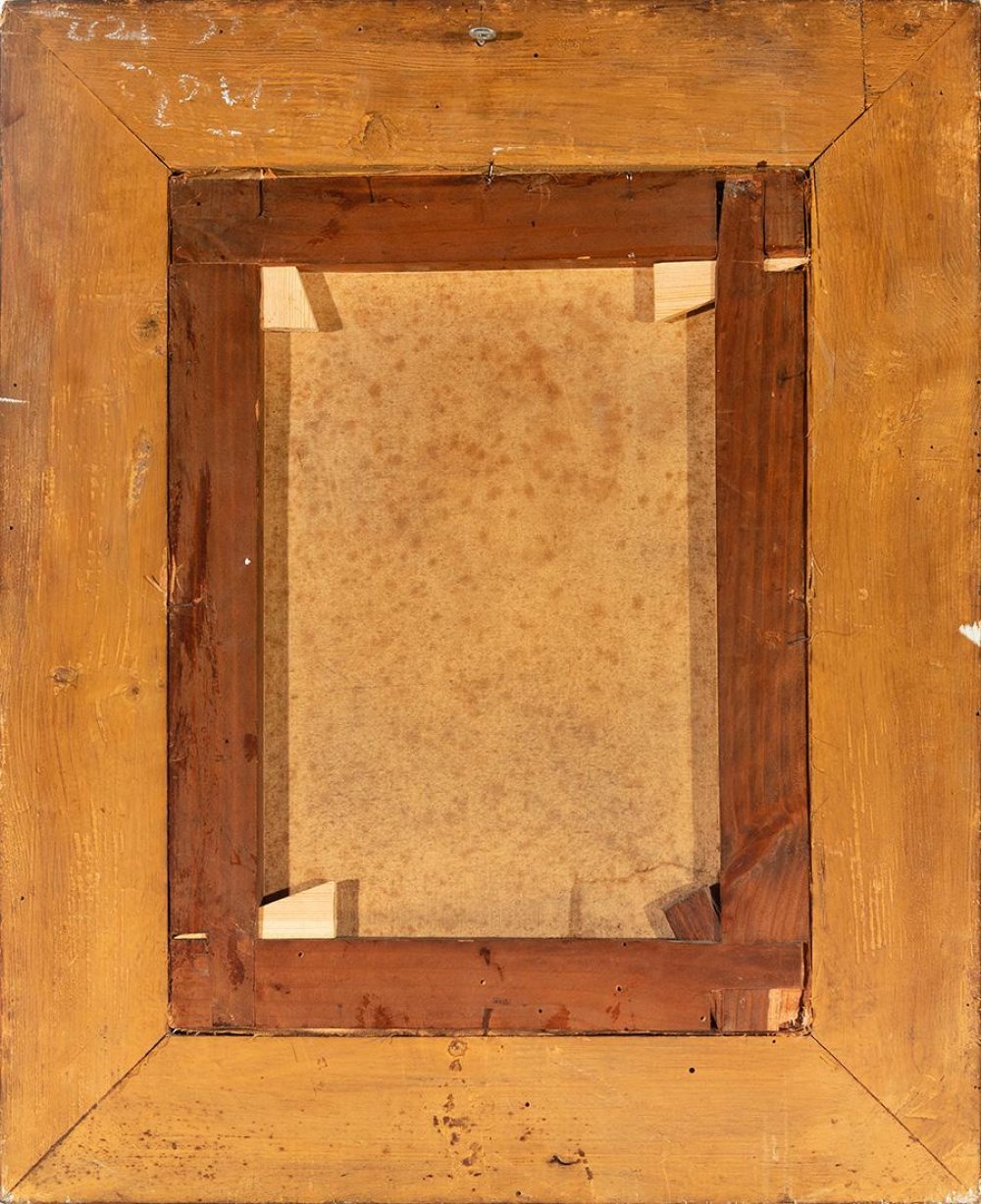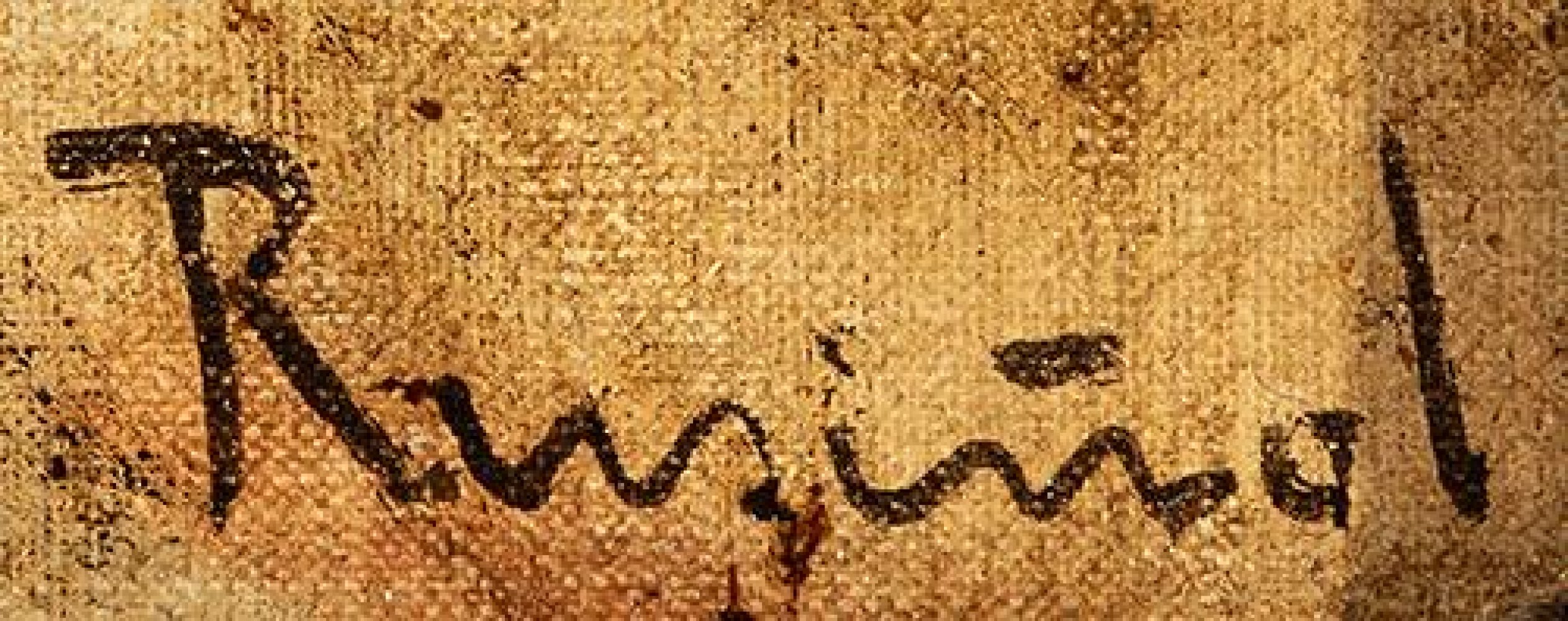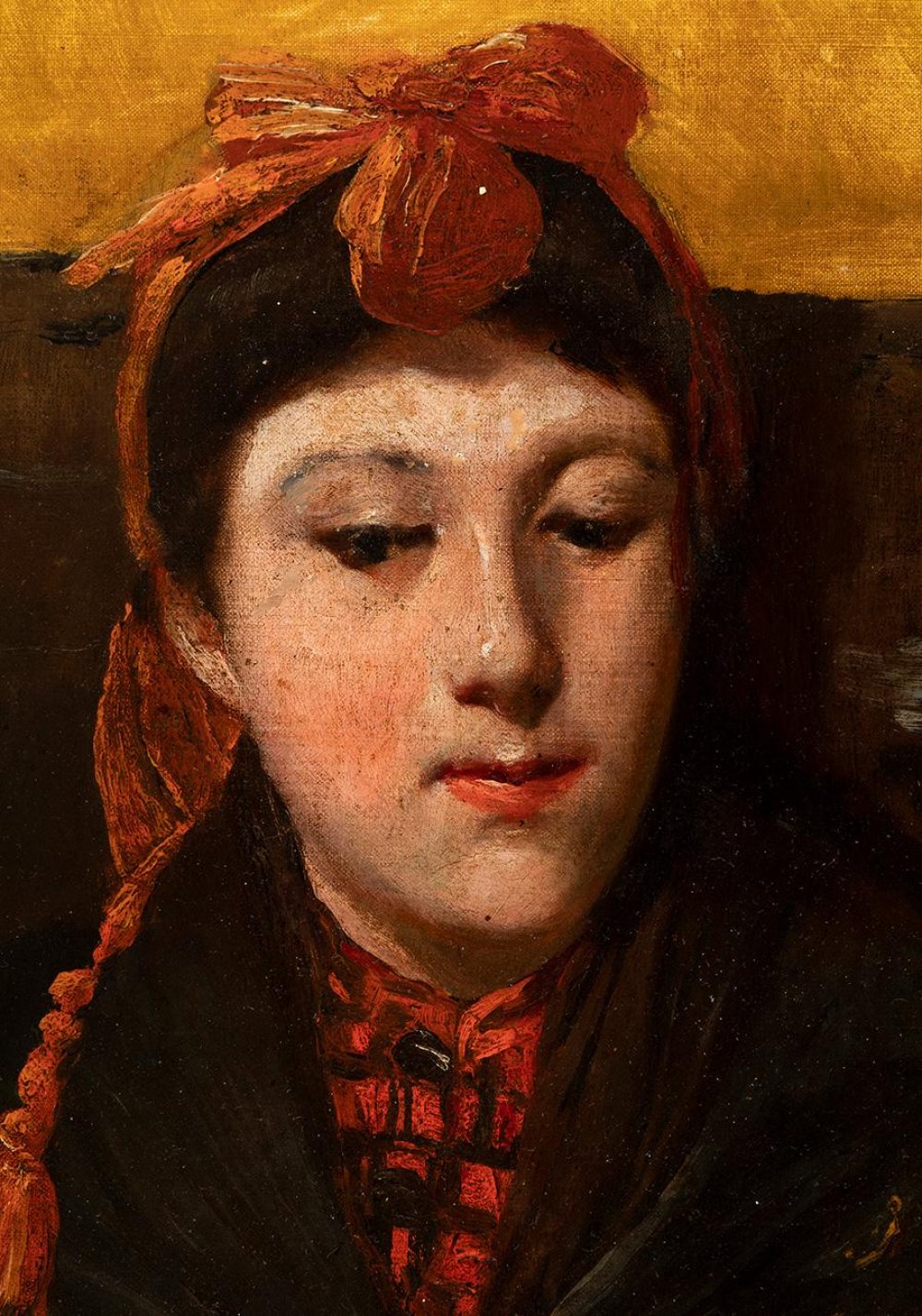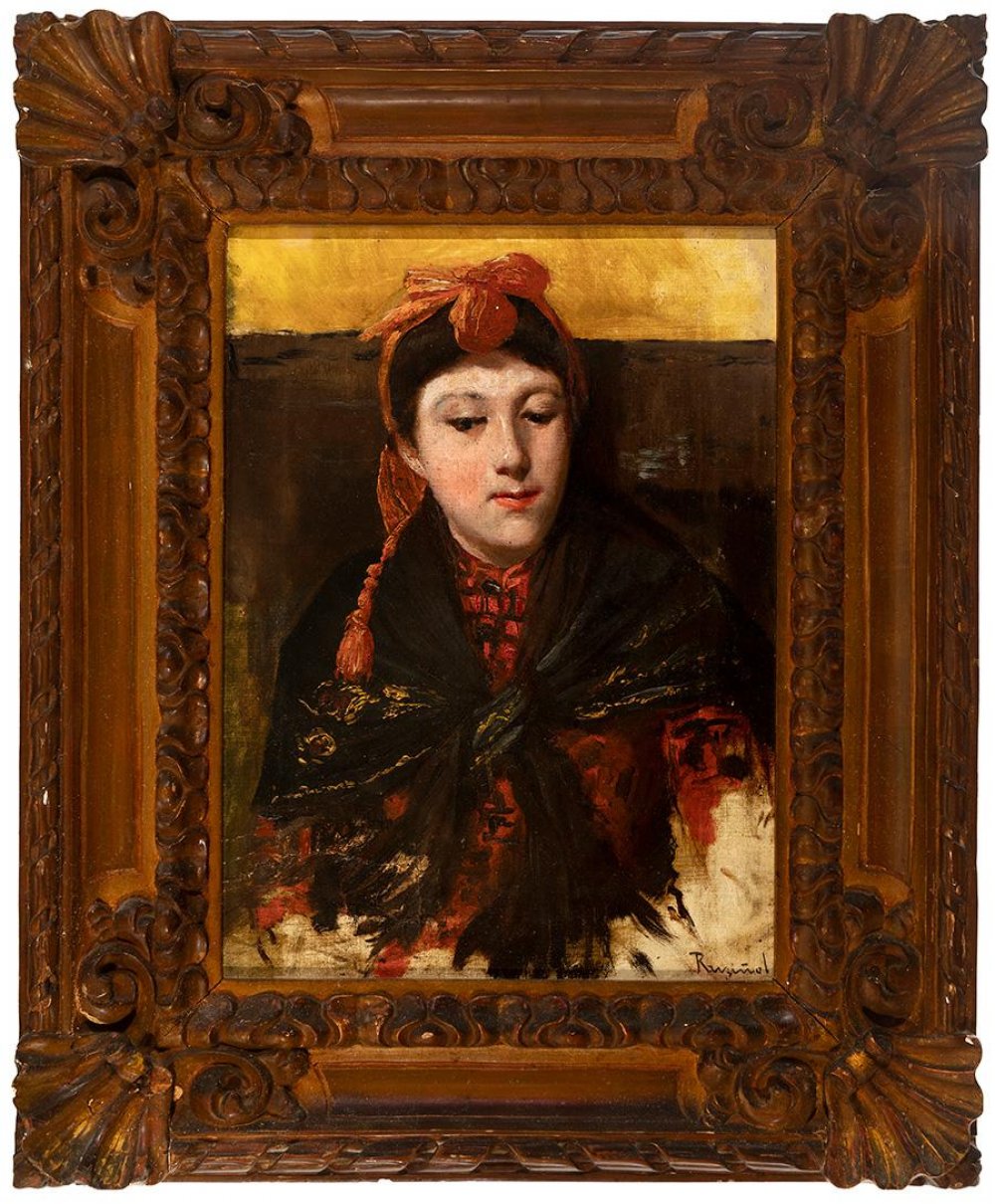2
SANTIAGO RUSIÑOL I PRATS (Barcelona, 1861 - Aranjuez, Madrid, 1931)."Female portrait", ca.1890.Oil
"Female portrait", ca.1890.
Oil on canvas.
Signed in the lower right corner.
Size: 41 x 30 cm; 58 x 47 cm (frame).
Among other pictorial genres, Santiago Rusiñol excelled in the genre of portraiture, especially female portraits. His gallery of self-absorbed, melancholic and withdrawn women is in keeping with the fin-de-siècle decadent taste. In the case of this young woman with her slanted gaze and half-closed eyelids, the face hides from direct contemplation, thus preserving its mystery and keeping it at a distance. The colourful, almost impressionistic brushstrokes with which the costumes, the patterned mantilla, the pleats, etc., are reproduced contrast with the naturalistic definition of the facial features. Rusiñol flirted with various avant-garde movements then in vogue, but his artistic personality stands out above specific styles.
Rusiñol was one of the main ideologists of the Catalan modernist movement. He trained as a disciple of Tomás Moragas and frequented the Centre of Watercolourists. He made his debut in 1884 at the Sala Parés in Barcelona, together with his friends Ramón Casas and Enric Clarasó. In those years he made a carriage trip around Catalonia with Casas, taking sketches of types and landscapes. The year 1888 marked a turning point in his career, as he began three new activities: he took part in the Paris Salon and held his first solo exhibition at the Sala Parés. The following year, 1889, Rusiñol settled in Paris, in the Montmartre district, with Utrillo, Clarasó and Canudas. He attended the academy of the painter Henri Gervex, and completed his training with Puvis de Chavannes and Carrière. The ruralism he had adopted in Barcelona disappeared and his style evolved towards naturalism. He also came closer to the thematic, but not technical, approaches of the Impressionists, as well as to their desire to capture a fleeting snapshot. In 1890 he established a relationship with Sitges, where he painted some of his first courtyards and gardens, a theme that would define his later style. That same year he held his first exhibition at the Sala Parés, together with Casas and Clarasó. In 1890 he returned to Paris with Casas and Utrillo. At this time he concentrated on depicting the entertainment venues of the area, such as the Moulin de la Galette, which featured in many of his paintings. However, in 1893 he left his studio in Montmartre and moved to the Île Saint-Louis. The following year he travelled to Italy with Zuloaga. On his return he exhibited the paintings made on this trip in what was to be his first personal exhibition at the Sala Parés. That same year he inaugurated the Cau Ferrat in Sitges, the seed of today's museum. In 1895 he made his first trip to Granada, and began the series "Gardens of Spain". In 1897 he produced some of his best paintings of gardens, an interest that also appears in his literary work "The Abandoned Garden", in which he cultivates a symbolist decadence. Around this time he exhibited in Paris at the Salon des Indépendants, at the Exposition Nationale and at the gallery of Samuel Bing, the main promoter of Art Nouveau in France. The latter, a solo exhibition held in 1899, brought international recognition to Rusiñol, whose success was based on a new vision of Spain, totally free of clichés and full of truth. From then on his activity multiplied as a painter, novelist and comedian, he premiered outstanding works in Madrid and Barcelona and held annual painting exhibitions at the Sala Parés, always with Casas and Clarasó. In 1908 he was awarded the medal at the National Exhibition of Fine Arts. He is represented in the Museo del Prado, the Museo Nacional de Arte de Cataluña, the Museo Camón Aznar in Zaragoza and the Thyssen-Bornemisza, among others.
"Female portrait", ca.1890.
Oil on canvas.
Signed in the lower right corner.
Size: 41 x 30 cm; 58 x 47 cm (frame).
Among other pictorial genres, Santiago Rusiñol excelled in the genre of portraiture, especially female portraits. His gallery of self-absorbed, melancholic and withdrawn women is in keeping with the fin-de-siècle decadent taste. In the case of this young woman with her slanted gaze and half-closed eyelids, the face hides from direct contemplation, thus preserving its mystery and keeping it at a distance. The colourful, almost impressionistic brushstrokes with which the costumes, the patterned mantilla, the pleats, etc., are reproduced contrast with the naturalistic definition of the facial features. Rusiñol flirted with various avant-garde movements then in vogue, but his artistic personality stands out above specific styles.
Rusiñol was one of the main ideologists of the Catalan modernist movement. He trained as a disciple of Tomás Moragas and frequented the Centre of Watercolourists. He made his debut in 1884 at the Sala Parés in Barcelona, together with his friends Ramón Casas and Enric Clarasó. In those years he made a carriage trip around Catalonia with Casas, taking sketches of types and landscapes. The year 1888 marked a turning point in his career, as he began three new activities: he took part in the Paris Salon and held his first solo exhibition at the Sala Parés. The following year, 1889, Rusiñol settled in Paris, in the Montmartre district, with Utrillo, Clarasó and Canudas. He attended the academy of the painter Henri Gervex, and completed his training with Puvis de Chavannes and Carrière. The ruralism he had adopted in Barcelona disappeared and his style evolved towards naturalism. He also came closer to the thematic, but not technical, approaches of the Impressionists, as well as to their desire to capture a fleeting snapshot. In 1890 he established a relationship with Sitges, where he painted some of his first courtyards and gardens, a theme that would define his later style. That same year he held his first exhibition at the Sala Parés, together with Casas and Clarasó. In 1890 he returned to Paris with Casas and Utrillo. At this time he concentrated on depicting the entertainment venues of the area, such as the Moulin de la Galette, which featured in many of his paintings. However, in 1893 he left his studio in Montmartre and moved to the Île Saint-Louis. The following year he travelled to Italy with Zuloaga. On his return he exhibited the paintings made on this trip in what was to be his first personal exhibition at the Sala Parés. That same year he inaugurated the Cau Ferrat in Sitges, the seed of today's museum. In 1895 he made his first trip to Granada, and began the series "Gardens of Spain". In 1897 he produced some of his best paintings of gardens, an interest that also appears in his literary work "The Abandoned Garden", in which he cultivates a symbolist decadence. Around this time he exhibited in Paris at the Salon des Indépendants, at the Exposition Nationale and at the gallery of Samuel Bing, the main promoter of Art Nouveau in France. The latter, a solo exhibition held in 1899, brought international recognition to Rusiñol, whose success was based on a new vision of Spain, totally free of clichés and full of truth. From then on his activity multiplied as a painter, novelist and comedian, he premiered outstanding works in Madrid and Barcelona and held annual painting exhibitions at the Sala Parés, always with Casas and Clarasó. In 1908 he was awarded the medal at the National Exhibition of Fine Arts. He is represented in the Museo del Prado, the Museo Nacional de Arte de Cataluña, the Museo Camón Aznar in Zaragoza and the Thyssen-Bornemisza, among others.
22nd September - 19th & 20th Century Art
Sale Date(s)
Venue Address
General delivery information available from the auctioneer
Setdart offers Worldwide shipping
PICK UP IN ROOM: You can come and pick up your lots in our offices (Barcelona, Madrid or Valencia). At the moment of the withdrawal, you will be able to accept the current conditions of the lot by means of a document that you will sign.
YOU CAN SEND ANOTHER PERSON TO PICK UP: This person must present a signed authorization that you can find in our web page by accessing from BUY AT SETDART- LOGISTICS-DOWNLOAD AUTHORIZATION DOCUMENT. You can also send an e-mail with the requested data in AUTHORIZATION DOCUMENT to admin@setdart.com
Important Information
25% buyer´s premium
21% buyer´s premium at www.setdart.com
Terms & Conditions
The maximum period to pay the lots is 7 working days. You can pay either via bank transfer or with credit card through our platform www.setdart.com (we only accept VISA or Mastercard).
BUYER´S PREMIUM: 22% Hammer price + 21% VAT from the buyer´s premium
If your piece has more than 100 years, our Ministry of Culture requires an export certificate in order for the piece to leave the country. Note that if the piece goes inside the EU, there is no cost for the export certificate. If the piece goes outside the EU, there is a cost for the export certificate. You can find more information in our Ministry of Culture website: https://www.culturaydeporte.gob.es/en/cultura/patrimonio/exportacionimportacion/exportacion/tasas.html
INQUIRIES: admin@setdart.com
Setdart guides you through the entire process, from the time of award to the day you receive your lot. Our logistics team will be happy to manage your transport, and will advise you on the best shipping method with professionals from the sector used to handling works of art and jewelry.
WE OFFER WORLDWIDE DOOR TO DOOR SHIPPING
PICK UP IN ROOM: You can come and pick up your lots in our offices. At the moment of the withdrawal, you will be able to accept the current conditions of the lot by means of a document that you will sign.
YOU CAN SEND ANOTHER PERSON TO PICK UP: This person must present a signed authorization that you can find in our web page by accessing from BUY AT SETDART-LOGISTICS-DOWNLOAD AUTHORIZATION DOCUMENT. You can also send an e-mail with the requested data in AUTHORIZATION DOCUMENT to admin@setdart.com
SETDART IS NOT RESPONSIBLE FOR THE STATE OF THE PARTS ONCE THEY LEAVE OUR FACILITIES. MRW SHIPMENTS: Once the payment is made, your lot will be packed for shipment, the logistics department will send you an e-mail notifying you of the day it leaves our warehouse, changes of address cannot be made after receiving this e-mail.
INSURANCE INCIDENTS: Coverage for the value of the auction up to 3000 ? per shipment, if the value of the auction is higher, Setdart will send you a quote including the additional insurance. The insurance company WILL NOT BE RESPONSIBLE FOR THE SHIPMENT THAT EXCEEDS THAT AMOUNT AND IS NOT FULLY INSURED. MRW INCIDENTS: Maximum notification 48 hours after receipt, after which the insurance company WILL NOT BE RESPONSIBLE AND NO CLAIMS WILL BE ACCEPTED.
E-MAIL LOGISTICS: logistica@setdart.com
PICK UP YOUR MESSAGES: You can send your own messaging, prior notice via e-mail that your shipment is ready, please note 3 or 4 days in advance. This type of shipment is packaged so Setdart will provide you with a quote.
EXPENSES FOR STORAGE: We inform you that if the purchased lot is not picked up within a month, you will be charged 30€ per week per lot. Setdart Online S.L., owner of the web site "setdart.com", "setdart.net" and "setdart.org", acts as a company of Spanish nationality inscribed in the Volume 36955, sheet 182, page B-293056 of the Mercantile Registry, with registered office at Calle Aragó















